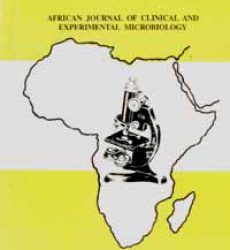Abstract
Differences are known to occur in prevalence rates in urinary tract infections (UTI) between men and women due to the difference between the urinary tracts of the sexes. Moreover, different organisms are known to infect and cause bacteriuria in men. When urine samples from 55 apparently healthy male students of Redeemer’s University were examined, nine bacteria species including Micrococcus luteus, Viellonella parvula, Micrococcus varians, Streptococcus downei, Streptococcus pneumonia, Bacillus subtilis, Streptococcus pyrogenes, Staphylococcus saprophyticus,and Enterococcus aquimarinus were isolated from the samples. The two most prevalent organisms reported in this study were Micrococcus luteus (40%) and Micrococcus varians (27.3%). The implication of the high prevalence rates (54.5%) of asymptomatic bacteriuria obtained in this population is discussed.
Key words: Asymptomatic UTI, bacteriuria, Micrococcus luteus
Download full journal in PDF below

